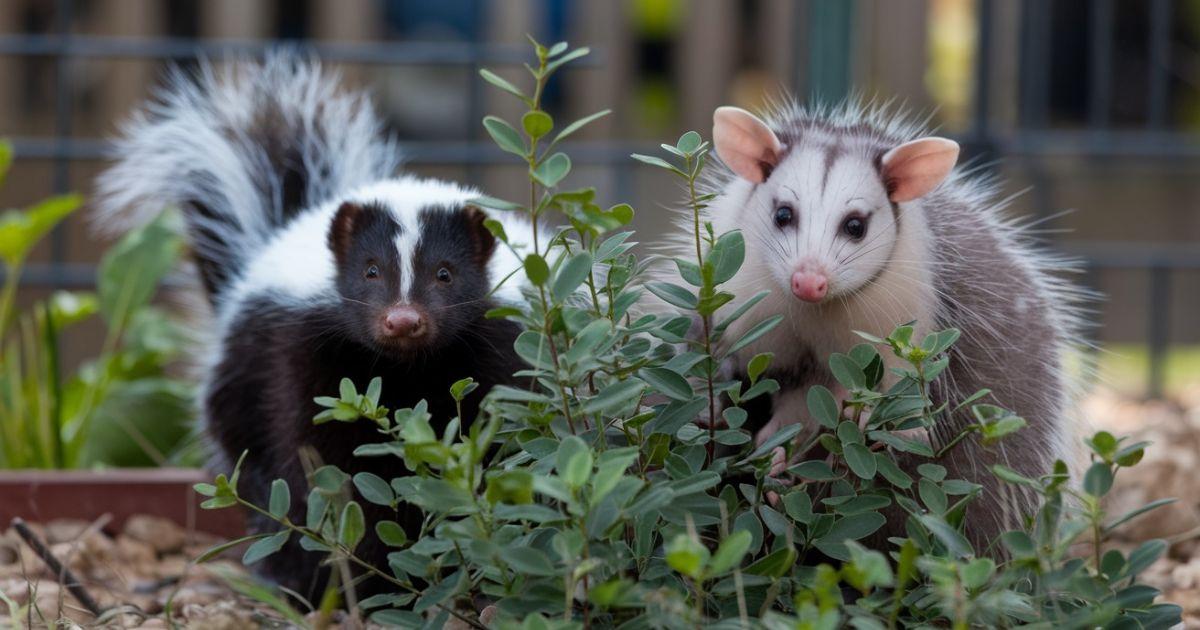When exploring the wildlife in your area, it’s common to encounter skunks and opossums. These animals play important roles in their ecosystems but can pose challenges for homeowners. Understanding their behaviors and habitats can help you manage their presence around your property.
Skunks are often removed from properties due to their potent spray, which can be a nuisance. It’s essential to know that they typically roam at night for food, making them more likely to dig in gardens or forage through trash. On the other hand, opossums are generally beneficial; they help control pests like ticks and are less likely to cause property damage.
As you navigate the dynamics between your home and local wildlife, consider the advantages and disadvantages of each species. Recognizing why skunks need removal and how opossums can contribute positively to your environment can inform your decisions regarding wildlife management.
Understanding Skunks and Opossums
Both common skunks and opossums play significant roles in local ecosystems. They exhibit unique behaviors and traits that make them important to your understanding of wildlife in residential areas.
Habitat and Behavior
Common skunks are adaptable creatures in diverse habitats, including forests, grasslands, and urban areas. They thrive in environments where food sources, such as insects and small mammals, are plentiful. Skunks are mostly nocturnal and are known for their distinct defense mechanism, spraying a foul-smelling liquid when threatened.
On the other hand, opossums prefer wooded areas or areas with dense underbrush but often venture into residential neighborhoods for food. They are also nocturnal and have a unique “playing dead” trait to evade predators. Opossums are opportunistic feeders, consuming fruits, insects, and even carrion. Their ability to regulate body temperature enables them to thrive in varying climates.
Identification and Characteristics
Common skunks are easily identified by their black-and-white fur and bushy tails. They typically weigh between 6 and 10 pounds and measure about 20 to 30 inches in length. Their characteristic odor warns of potential threats, making visual identification less critical.
Opossums are North America’s only marsupials, notable for their pointed snouts and prehensile tails. They range in size from 4 to 14 pounds, with a body length of 18 to 40 inches. Their fur is usually grayish-white, and they have a distinctive hairless tail. Recognizing these traits is essential for identifying them in residential areas, where both animals frequently visit.
Management and Control
Effective management and control of skunks and opossums involve prevention techniques, understanding removal needs, and addressing local concerns. Targeting targeted strategies can minimize potential issues associated with these animals.
Prevention and Exclusion
Implement a combination of prevention strategies to deter skunks and opossums from invading your property. Keep food sources secure by using airtight containers for pet food and removing outdoor food waste. Maintaining your yard is essential; trim dense vegetation and remove debris where these animals can hide.
Fencing can also be an effective barrier. Install a fence at least three feet high, buried six inches deep, to prevent digging. Seal holes or gaps around your home’s foundation and entrances to reduce access points.
Removal Reasons and Methods
Understanding the reasons for removing skunks and opossums from your property is essential. Common reasons include potential property damage, health concerns from diseases (like leptospirosis), and the risk of attracting other pests. Skunks may dig up lawns in pursuit of grubs, while opossums can rummage through trash.
Consider humane traps for removal. These traps should be checked frequently to avoid causing undue stress to the trapped animal. Relocation should be done according to local guidelines, as some areas have regulations on wildlife relocation. If you’re unsure, contact a wildlife professional for assistance.
Local Concerns in Dallas
In Dallas, skunks and opossums pose specific challenges. They often nest in urban areas, causing property damage and creating sanitation issues. Skunks may spray when threatened, leading to unpleasant odors in your neighborhood.
Residents should be aware of health risks like rabies and other zoonotic diseases. Report any sightings to local wildlife agencies to monitor population trends and ensure public safety. Engage in community awareness programs to educate others on prevention and control methods, enhancing overall neighborhood harmony.
Calling In The Professionals
Encountering skunks and opossums can pose significant risks in Dallas. These animals may carry diseases such as rabies and become aggressive if cornered. Addressing any wildlife issues promptly is crucial to avoid potential health hazards.
Common Problems Caused by Skunks and Opossums in Dallas:
- Property Damage: Skunks and opossums may dig up lawns and gardens, damaging your landscape.
- Odor Issues: Skunks are notorious for their strong odor, which can linger around your home.
- Health Risks: Both animals can transmit diseases, posing a risk to pets and family members.
If you encounter a wildlife problem, it’s wise to call in professionals. Attempting to handle the situation on your own could result in injury or further complications.
Why Choose Professional Help?
- Expertise: Professionals understand animal behavior and can safely relocate creatures.
- Humane Solutions: Companies like Critter Stop use humane methods to remove wildlife without harm.
- Prevention Strategies: Experts can offer guidance on how to prevent future intrusions.
For effective and safe wildlife removal, consider calling Critter Stop at (214) 234-2616. They have a fantastic reputation, and numerous positive customer reviews online for their high-quality work and excellent customer service. Don’t wait; a free inspection can put your mind at ease and help solve your wildlife concerns.
Keep an eye for more news & updates on The Updates News!
